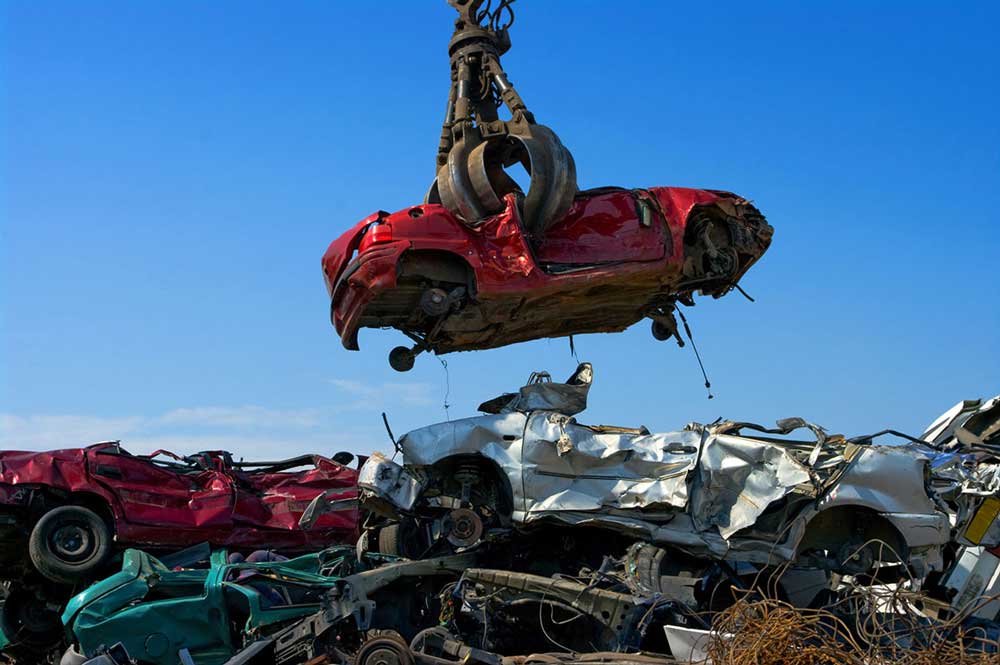

This is happening people, whether we’re ready or not. And to be completely honest, if we want to do this right, we’re not.
Our transportation is going electric. That’s a good thing, since roughly 28% of annual U.S. greenhouse gas emissions comes from the cars, trucks, buses, and planes we use to get from our Point As to our Point Bs. Around the world, governments and automakers are pushing the pace of electrification with new mandates and new vehicles, all with the goal of reducing the use of fossil fuels and arresting the trends of harmful climate change.
Dominoes have been lining up in this arena for decades now, with manufacturers rolling out a limited number of electric vehicles (EVs) each year, and charging stations popping up intermittently around the nation. And since the start of 2021, some of the biggest dominoes have fallen and the pace is picking up.
In late January, General Motors was the first U.S. automaker to commit to an all-electric slate of vehicles, targeting the year 2035. Weeks later, Ford Motor Co. announced it would spend $22 billion on electric vehicle development by 2025, and that the only new cars it would offer in Europe by the end of the decade would be electric. On the last day of March, President Joe Biden rolled out a $2 trillion infrastructure plan that included a whopping $174 billion to encourage EV adoption.
But this is happening atop an EV ecosystem that already has problems, right here, right now. Some are technical puzzles that need to be solved, while others are weightier issues of social equity and environmental stewardship. In some instances, they’re a bit of both.
Does our reliance on materials such as lithium, cobalt and nickel put undue pressures on the countries with these resources? If we’re to replace the more than 1.3 billion vehicles already on the road, do we know how to maximize battery utilization by using them in less demanding applications after their original automotive life? Can we design batteries to be properly recycled, reducing the strain on communities that are home to landfills, or collection and recycling facilities, often located in poorer areas? Can we get the necessary public buy-in on EVs by building awareness of the total cost of ownership, educating incumbent workers, and reducing barriers in charging accessibility even at remote locations or congested urban locations to make them a possibility for all demographics?
The work of University of Michigan engineers across a variety of disciplines provides a broad perspective of these challenges and how society might meet them. These professors are engaged in research and program development to address many of the challenges, finding ways to translate intricately technical work into benefits to the larger global community.
“We’re connecting the dots to enable a circular battery ecosystem with repurposing and remanufacturing,” said Anna Stefanopoulou, the William Clay Ford Professor of Technology and a professor of mechanical engineering. “We’re bridging the gaps between end of life for the batteries and new ways to use their materials. We are designing batteries for multiple lives and creating the tools and means to handle them safely.”
With Ann Arbor located at the core of auto manufacturing and its supply chain, along with a state-of-the-art battery user facility and Mcity’s automated vehicle testing campus, U-M’s researchers are in a unique position to take on a unique challenge. They are confronting the global electric vehicle scale-up problem by working to ensure batteries for transportation will be reliable and affordable, while limiting environmental and social damages.
EVs require elements such as lithium and cobalt, which are often found in countries without strong environmental protections. Now that auto companies are going all-in on the new technology, those countries will be under increased pressure to produce the needed resources.
 Workers in a cobalt mine. Photo: Adobe
Workers in a cobalt mine. Photo: Adobe
A decade ago, an environmentally-conscious U.S. consumer in the market for a fully electric vehicle had just a handful of options: a pair of smart cars, Tesla’s three-year-old Roadster, a BMW and the Nissan Leaf. But the writing was already on the wall, and U-M’s Greg Keoleian was among those reading.
If this was the beginning of some kind of wave, one simple question needed to be addressed immediately: Was there enough lithium for the batteries needed to power an electric vehicle revolution?
Keoleian, the Peter M. Wege Endowed Professor of Sustainable Systems in U-M’s School for Environment and Sustainability and professor of civil and environmental engineering, partnered with Ford Motor Co. to provide an answer. The team estimated that enough lithium exists to support electric vehicles until the end of the century, a finding that has served as an industry benchmark ever since.
Sounds good, but sourcing lithium is time intensive, uses both harsh chemicals and massive amounts of water, and creates large amounts of waste. A front-page article in the New York Times put it this way: “Production of raw materials like lithium, cobalt and nickel that are essential to these (electric vehicle and renewable energy) technologies are often ruinous to land, weather, wildlife and people.”
For example, chemicals leaking from China’s Ganzizhou Rongda Lithium operation were linked to fish die-offs along the Liqi River in 2016, according to Wired. Dead cows and yaks were also discovered downriver.
“It was the third such incident in the space of seven years in an area which has seen a sharp rise in mining activity, including operations run by BYD, the world’s largest supplier of lithium-ion batteries for smartphones and electric cars,” Wired stated. “After the second incident, in 2013, officials closed the mine, but when it reopened in April 2016, the fish started dying again.”
Cobalt is used in battery cathodes and comes primarily from the Democratic Republic of Congo (DRC). According to a blog posted on the Council on Foreign Relations website in October, between 15% to 30% of the mining there is done by small-scale or artisanal operations.
“For years, human rights groups have documented severe human rights issues in mining operations… Child labor, fatal accidents and violent clashes between artisanal miners and security personnel of large mining firms are recurrent.”
Those concerns are among the reasons U-M researchers study which materials and manufacturing processes can create the next generation of electric vehicle batteries.
Today’s lithium-ion batteries feature an anode and cathode, each of which store lithium at different times during the charging/powering process. Between them is the electrolyte, usually liquid, that carries lithium ions back and forth.
U-M’s efforts to find and verify alternatives include lithium metal, solid-state batteries which use a solid electrolyte in place of liquid electrolytes currently in use, lower-purity lithium, aged cathodes and almost everything in between. By researching ways to harness abundant materials for battery production or reuse older materials, they hope to relieve the disproportionate pressure placed on countries like DRC for cobalt or the Philippines for nickel.
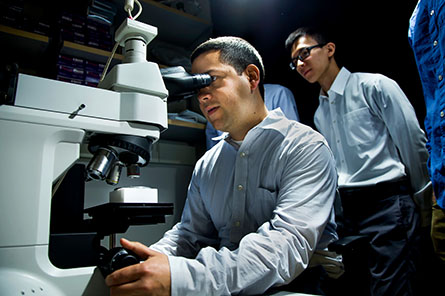 A visualization cell allows Neil Dasgupta, a U-M assistant professor of mechanical engineering, to view how dendrites form in lithium-ion batteries. Dendrites are a safety issue for today’s standard EV batteries. Photo: Joseph Xu/Michigan Engineering
A visualization cell allows Neil Dasgupta, a U-M assistant professor of mechanical engineering, to view how dendrites form in lithium-ion batteries. Dendrites are a safety issue for today’s standard EV batteries. Photo: Joseph Xu/Michigan Engineering
“Look at something like a lithium sulfur battery,” said Neil Dasgupta, a U-M associate professor of mechanical engineering and Miller Faculty Scholar. “Sulfur is one of the most abundant elements in the Earth’s crust. And it can be used as material for a cathode—the battery’s positive electrode.
“But the problem with sulfur is that it tends to dissolve when you use it in normal liquid batteries. When it dissolves into the liquid electrolyte, it can shuttle across the battery to the other side and lead to degradation of the battery.
“With our research in solid-state batteries, in collaboration with Jeff Sakamoto and Don Siegel, we’re looking into whether you could enable sulfur as an alternative cathode—allowing you to operate without cobalt.”
Don Siegel’s work could eventually lead to EVs without lithium altogether. The U-M professor of mechanical engineering has spent years pushing the limits of what hydrogen fuel cell technology can do. It holds the promise of zero emissions using one of the most abundant elements on the planet.
Other projects in this area
Much of the body and drive train of current electric vehicles is difficult or not economically feasible to recycle. An inability to reuse most of those materials will send more waste to landfills, which are traditionally located in poorer communities.
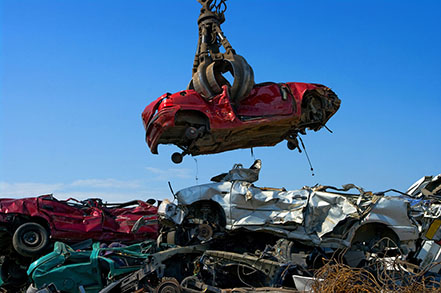 Car at a junkyard. Photo: Adobe
Car at a junkyard. Photo: Adobe
To reach the point where your typical EV gets you 250 miles or more on a single charge, engineers have made a point of lightweighting their vehicles. A lighter car requires less energy to move, making it more efficient in its power needs.
Low carbon steel, the mainstay of internal combustion-powered automobiles for a century, is being replaced by materials such as aluminum in an effort to bring weights down. Yet, by doing so, EVs present a host of problems when it comes to recycling.
“We already recycle many of the materials that are going into these new vehicles, but we don’t do it well,” said Daniel Cooper, a U-M assistant professor of mechanical engineering. “It requires putting the steel and aluminum into electric-arc or gas-fired furnaces, and then casting new metal.”
Having mixed substances in the furnace can lower the quality of the recycled end product, which is why this process is often called downcycling. For example, recycled steel can crack during manufacturing if it contains as little as 0.1%of copper. Typically, the recycled metal ends up in applications with low-performance requirements such as aluminum castings (e.g., engine blocks) and steel reinforcing bars.
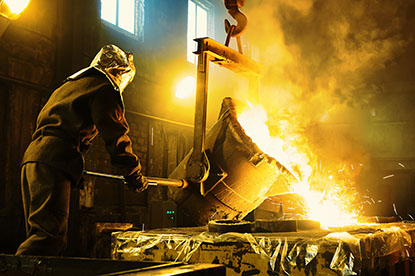 Electric-arc or gas-fired furnaces typically handle the materials of current EVs at the end of their lives. Recycling those materials, as well as EV batteries, presents a host of problems. Photo: Adobe
Electric-arc or gas-fired furnaces typically handle the materials of current EVs at the end of their lives. Recycling those materials, as well as EV batteries, presents a host of problems. Photo: Adobe
Recyclers will try to break apart vehicles using mechanical shears, creating piles of different metals that can be sent, individually, to the furnaces. But it’s a difficult task when vehicles contain many different alloys mixed together, and aluminum car panels often have steel rivets that are hard to remove even with magnets. This task of separating the metals is only getting more difficult as, for example, electric vehicles use even more copper wiring in their electronics.
In the U.S., there is little demand for these contaminated scrap metals, so the materials are often shipped to other countries to be sorted by hand by low-paid workers.
Cooper and U-M engineers are leading a U.S. Department of Energy-backed project focused on new material and vehicle lifecycle system designs.
“Our work shows a coming wave of aluminum-sheet intensive vehicles that will reach their end of life over the next few years and make their way to scrap yards,’ he said. “We need to reimagine how such high-value materials can be recycled or remade to produce new vehicles.”
Dubbed “The Clean Sheet Project,” the effort seeks to develop new design tools and establish best practices for material producers and carmakers to take recycling into account from start to finish in production. While the group’s initial focus will be on sheet metals, it could eventually include guidelines for all manner of materials, from plastics to polymers and electric vehicle batteries.
“Aluminum is known for being tricky to recycle without a loss of performance, and you can see why some people are getting nervous about where we’re heading,” Cooper said. “If we are switching to EVs, that probably means even greater demand for high-quality aluminum and a loss of the internal combustion engine and transmission market that currently uses a lot of the low-quality recycled metal.”
“To reduce the environmental impacts of vehicle production going forward, we need new designs for recycling tools and methods for energy-intensive aluminum and advanced high-strength steel automotive sheets. The goal is to boost the production of these sheets from recycled materials, which will reduce production emissions and the destructive mining for raw materials.”
To reap the environmental benefits of electrification, consumers need to adopt the technology. Safety issues and limited range threaten to keep some away.
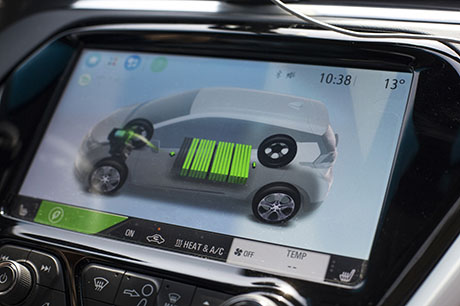 Electric display of car battery. Photo: Adobe
Electric display of car battery. Photo: Adobe
Without the arrival of commercial lithium-ion batteries in the early 1990s, we might have missed out on a lot. The rechargeable breakthrough unplugged our first clunky laptop computers, put iPods and iPhones in our pockets and, now, they’ve put the first mass-produced electric vehicles out onto the roads.
But the technology is nearing its peak in terms of the amount of energy it can store, a major problem for its use in EVs. In addition, lithium-ion batteries still come with the potential to cause onboard fires.
Over the past decade, U-M researchers have resurrected a once-discarded technology—the lithium metal battery—as a potential LIB successor. To make it work in today’s EVs, this next-generation version of the lithium metal battery would get an upgrade as a solid-state battery—in other words, its electrolyte is a solid rather than a liquid.
Work at U-M has resulted in an all-solid battery technology that could double the range of current EVs while avoiding the combustion issues that impeded widespread adoption of lithium metal technology in the past.
Rechargeable lithium metal batteries were briefly considered the next big thing in the 1980s. Initially, these batteries reached the consumer market in early portable phones, until safety concerns came to a head. They utilized lithium metal in place of the graphite that makes up a lithium-ion battery’s anode. But they also utilized liquid electrolytes—the components that allow lithium ions to flow between the cathode and the anode. Lithium shuttling between the electrodes tended to build tree-like filaments called dendrites on the electrode surfaces, eventually shorting the battery and causing fires. That put lithium metal on the backburner, and led materials scientists and engineers in a different direction.
The lithium-ion battery circumvented the dendrite issue using the safer graphite for the anode, with the tradeoff of less energy density. It quickly became the industry standard.
Now, advances in lithium metal, solid-state technology from U-M and other teams have caught the eye of major industry players, like GM, looking for the next step forward. In April, the automaker announced it would invest nearly $140 million in SES, a lithium metal battery developer.
Jeff Sakamoto and his U-M team have pushed lithium metal technology even further, utilizing a solid-state electrolyte to boost range. And their “anode-less” lithium metal battery being developed in Ann Arbor could double EV range and improve safety, while simultaneously reducing production costs. This could lead to vehicle costs closer to those of traditional internal combustion engine cars.
Their approach harnesses the lithium already contained within cathode materials. Lithium metal is reactive and weak, making it extremely difficult to handle and integrate into batteries, especially using state-of-the-art manufacturing equipment. The team created a workaround that essentially allows the battery to build itself. When the battery is charged for the first time, the lithium ions on the cathode side of the cell are extracted and moved to the anode side of the cell—effectively synthesizing a lithium metal anode.
“Because we can use electrochemistry to make the battery “build” its own lithium metal anode, we can completely eliminate that step of the manufacturing process. Thus we can manufacture batteries that are initially ‘anode-free,’ said Sakamoto, a U-M associate professor of mechanical engineering and materials science.
By removing the anode—one key ingredient of the lithium ion’s three-component formula—U-M’s production method offers a potential reduction in manufacturing cost. And the fact the process can be completed using current lithium-ion battery manufacturing means EV makers could adapt U-M’s technology without having to completely retool their facilities.
“There is already a lot of capital investment that has gone into lithium-ion batteries,” Sakamoto said. “So if one were to think about replacing a current lithium-ion battery with a new kind of battery, that requires a completely different approach to manufacturing, and a whole lot more investment has to go into that.
“We hope the outcome of this work can enable substantial reductions in battery cost to achieve EV cost parity with internal combustion engine powered vehicles. When this happens, the widespread adoption of EVs will, hopefully, be imminent.”
Other projects in this area
Consumers have grown used to making quick stops at gas stations and leaving in just a few minutes with a full tank. Charging an EV takes longer, another drawback that may stop the public from embracing the technology.
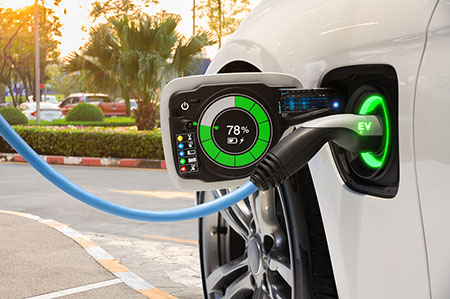 An electric car being charged. Photo: Adobe
An electric car being charged. Photo: Adobe
>Consumers who are on the fence about a jump to EVs often cite an underlying worry their vehicle could run out of power while out on the road, far from a place where they can recharge. A Consumer Reports survey in December showed range anxiety among the chief concerns blocking EV acceptance among U.S. motorists.
That perception and mindset create a roadblock engineers must help overcome. But even if, overnight, charging stations became as ubiquitous as the drug stores and gas stations that are seemingly everywhere, there would still be problems.
“Even if an electric car can drive 300 miles on a charge, we, as citizens worldwide, have become so used to this phenomenon of pulling into a gas station and pumping fuel—a process that takes us three to four minutes,” Dasgupta said. “Even with the most aggressive and fastest charging systems, it can take 30 minutes to fully charge your vehicles.
“That has significant implications for consumer acceptance.”
Drivers could choose to only partially charge their vehicle during stops. However, this would increase the number of charge-discharge cycles required, which would degrade the battery faster and decrease the lifetime before it needs to be replaced.
And that means range anxiety is a problem that can’t be solved solely by the addition of more charging stations. Faster charging is needed for consumers to see EVs as a good investment.
An EV range of 300 miles has been a benchmark for the auto industry, since it’s a reasonable distance for a traditional internal combustion vehicle to go on a single tank of gas. To reach that distance, engineers have had to make the electrode material increasingly thicker as a means of increasing range.
That thickness makes it harder to charge the battery quickly since lithium ions are forced to travel deeper and deeper inside the material.
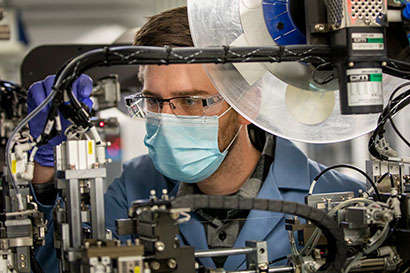 Eric Kazyak, a research fellow in mechanical engineering at U-M, works on solid state batteries—batteries that replace the liquid electrolytes found in traditional lithium-ion powered EVs with a solid electrolyte. By switching to a solid-state electrolyte, researchers are looking to improve the safety of EV batteries. Photo: Robert Coelius/Michigan Engineering
Eric Kazyak, a research fellow in mechanical engineering at U-M, works on solid state batteries—batteries that replace the liquid electrolytes found in traditional lithium-ion powered EVs with a solid electrolyte. By switching to a solid-state electrolyte, researchers are looking to improve the safety of EV batteries. Photo: Robert Coelius/Michigan Engineering
Dasgupta’s lab, in collaboration with Sakamoto and Katsuyo Thornton, utilizes laser manufacturing techniques to drill holes in the graphite anode of EV batteries, creating something akin to highways that allow lithium ions to get inside these thicker electrodes quickly.
“We’ve demonstrated that laser patterning alone enables the battery to charge in 10 minutes,” Dasgupta said. “Normally, if you try to fully charge your battery in only ten minutes, it’s going to degrade to the point that it is no longer useful after less than 50 charges.
“Our project overcomes the driving range versus charging time problem.”
Dasgupta’s work is, perhaps, particularly crucial right now. In May, researchers at the University of California Davis released survey results that showed between 2012 and 2018, one in five electric vehicle owners switched back to gasoline-powered cars.
The main reason? Dissatisfaction with charging.
Other projects in this area
Current EV batteries are difficult to recycle and their potential for a second life is unclear. They also contain toxic materials that pose an environmental threat in landfills.
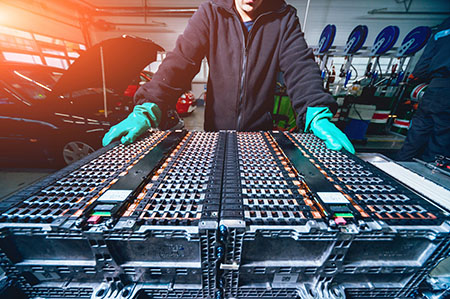 Charging the batteries of the electric motor. Photo: Adobe
Charging the batteries of the electric motor. Photo: Adobe
Long before a next generation battery makes its way into mass-produced EVs, we’re going to have to find a way to deal with what happens when an LIB finishes its time powering a car. And it’s not as easy as it sounds.
In November, Wired summed up the looming problem with this headline: “The Race to Crack Battery Recycling—Before it’s Too Late.”
“So much of the lithium-ion battery, once its usefulness is gone, is basically just a rock—solid waste that may leak toxic material or ignite,” said Donald Siegel. “It is literally not being harvested and re-used in the way that other materials are. And there’s going to be a ton more lithium-ion batteries flooding the market as EVs become more mainstream.
“Ideally, it would be like soda bottles—throw them in the recycling bin, someone comes and picks it up so the battery can be made again. The simple reason we can’t do that right now is the components don’t lend themselves to easy handling.”
As an example, your typical EV battery often covers the entire bottom of a vehicle. It can weigh up to 2,000 pounds and cost in the neighborhood of $10,000. So swapping out a battery is no small task.
The design of most EVs doesn’t make for an easy in-and-out experience.
“If you look at current battery packs, they’re assembled using glue,” said Jason Siegel, an associate research scientist in U-M’s Department of Mechanical Engineering. “They’re not meant to be disassembled and have a single cell taken out.”
That part is key, since EV batteries can have anywhere from several dozen individual cells to 2,000 or more. In the interest of repurposing, it would help to know which cells still have adequate capacity and internal resistance (which is a big factor in for acceleration).
A used EV battery no longer effective at powering a car might be perfectly good for storing solar energy at a home to use later for vehicle charging or providing backup power to the electrical grid.
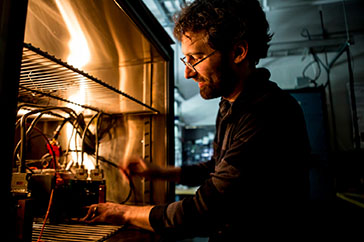 Jason Siegel, a U-M assistant research scientist in mechanical engineering, models a lithium-ion battery in the Fuel Cell Control Systems Laboratory in the Automotive Research Center on North Campus. Photo: Joseph Xu/Michigan Engineering
Jason Siegel, a U-M assistant research scientist in mechanical engineering, models a lithium-ion battery in the Fuel Cell Control Systems Laboratory in the Automotive Research Center on North Campus. Photo: Joseph Xu/Michigan Engineering
So many questions about what could be, but with EVs still only 3% of global car sales, and with a typical lifespan greater than a decade, there isn’t a ton of data to work with yet. And running laboratory tests to find that point is expensive and time consuming.
So being able to make accurate predictions utilizing in-use field data and simulations will help determine whether it’s economically feasible to repurpose EV batteries. To get the minimum amount of data necessary to determine exactly when a battery is likely to start sliding down the capacity-loss curve, U-M teams employ algorithms.
Through computer simulations, U-M researchers are establishing baseline performance data to help predict the possibilities for EV batteries or individual cells.
“We’re trying to understand what the utility of these batteries is,” Jason Siegel said. “How do we take them out of the vehicle, identify which cells are good for reuse and which aren’t, and sort them for recycling or repurposing?”
U-M teams employ algorithms for deep diagnostics without invasive or destructive tests for fast assessment. The programs can run on-board a vehicle or at a local shop to assess battery health and guide repairs.
In fact, Stefanopoulou and others are re-imagining how your neighborhood oil-change shop will look as EVs age and are increasingly used as families’ primary vehicles. There is a need to develop tools, data analytics, and standards to assess the batteries, work being done by Youngki Kim, an assistant professor of mechanical engineering at U-M Dearborn.
These advanced diagnostics rely on signal interpretation watching for intrinsic shift of phase transitions in the battery material as it ages. These shifts create a wrinkle-like “aging signature,” which Stefanapoulou’s team detects—a process she jokingly refers to as looking for “aging wrinkles” in the lab.
Other projects in this area
With fewer moving parts and new technologies, the EV represents a major change from traditional vehicles. And that imperils the current industry structure —from vehicle manufacturers, to parts suppliers to mechanics.
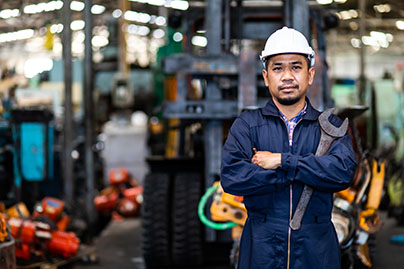 A worker stands with a wrench. Photo: Adobe
A worker stands with a wrench. Photo: Adobe
It can be difficult to grasp how truly huge the internal combustion engine universe is. From parts manufacturers, to assembly line workers to local repair shops, this world-altering invention has helped put food on the tables of families for well over a century.
But the electric vehicles becoming a larger part of the auto industry’s annual output are a much different animal than their predecessors. And they have the potential to disrupt that entire universe.
“Additional skill sets will be required for technicians and engineers going into product development or automotive service in dealerships,” said Al Lecz, director of the Advanced Transportation Center at Washtenaw Community College (WCC) in Ann Arbor. “Those will have to focus on batteries, motors, software and electronic controls and sensors.“But you’re also looking at a new slate of customer concerns that will need to be resolved regarding performance characteristics at all weather and use patterns. That’s going to be of particular concern during winter and summer driving where heaters and air-conditioning are engaged.”
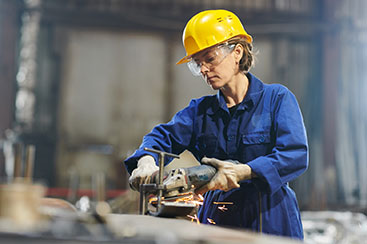 The move toward electric vehicles represents a seismic change for the traditional auto industry. It will mean a host of changes that include retraining a large workforce that has been centered around the traditional internal combustion engine for generations. Photo: Adobe
The move toward electric vehicles represents a seismic change for the traditional auto industry. It will mean a host of changes that include retraining a large workforce that has been centered around the traditional internal combustion engine for generations. Photo: Adobe
More than 20 members of U-M’s engineering faculty are committed to helping the transition to electrification by educating future battery technologists, as well as teaching the teachers who will, in turn, train technicians for EV manufacturing, testing, and repairs. They have formed a working group with a few community colleges and schools in Michigan, including WCC, to map the needs and prepare material that aggregates information for available courses or online educational modules.
“After talking to the leadership of the NAATBatt educational committee, we crowdsourced a list of battery courses at various institutions available across the U.S. and Europe,” Stefanopoulou said. “There is a significant interest across the globe on learning battery fundamentals and being part of the transition to electrification or left behind.
U-M is coordinating with a network of universities and community colleges to offer online modules for battery education so that it can be used and tailored to various skill-levels and ages by the broader community that might need to transition from internal combustion and fuels to batteries.
“The list also includes block courses for executive education like the one we are offering at the U-M battery lab for the last three years,” Stefanopoulou said. “The hands on component of this course is highly valued as it provides an exceptional insight of the critical steps of battery production and the importance of the supply chain. Opening the lab’s doors, literally or virtually, to more students from community colleges like WCC will be important.”
U-M’s Battery Fabrication and Characterization User Facility allows building lithium-ion batteries all the way from powders to pouch and cylindrical cells, the type found in cell-phones, computers and cars. The lab includes the roll-to-roll process of making batteries from mixing the anode and cathode material, coating the copper and aluminum current collectors, drying, and all the way to the formation cycling, which is the first charge and discharge of a battery cell.
“Having such a facility here, on campus, next to our classrooms and near all these automotive companies is instrumental to our mission of creating a comprehensive battery engineering education,” Stefanopoulou said. “It is truly a place where invention, manufacturing, and education meet.”
Widespread adoption of EVs will be elusive unless automakers can bring down vehicle prices.
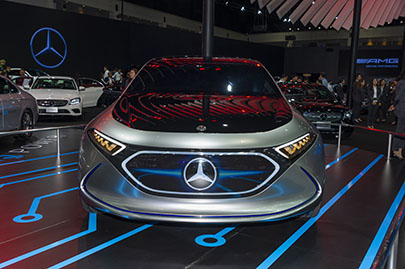 An electric Mercedes-Benz. Photo: Adobe
An electric Mercedes-Benz. Photo: Adobe
In February, the good folks at Car and Driver put together a helpful article for anyone considering an EV purchase, titled: “Here’s Every New Electric Vehicle Model for Sale in the U.S.”
Curious car shoppers had 19 models of fully electric vehicles they could choose from. Those ranged from the Porsche Taycan at the top end with its base price of $105,000 and a “desirability” that is “off the charts,” to the slightly less extravagant Mini Electric, with a starting price of $30,750 and looks that are “basically like every other Cooper, both inside and out.”
That’s a slate of fully-electric cars with an average starting price of roughly $54,000. Only five of the 19 fall under a base price of $40,000. As recently as 2019, the average new car—for all vehicles—cost $36,718, according to Kelley Blue Book.
So, as it currently stands, most electric vehicles fall outside the budget of a typical American family. And that’s a major problem if you’re hoping widespread acceptance of EVs will impact climate trends.
Now that’s where the federal government comes in. To help bring this new technology to the masses, the U.S. Department of Energy offers as much as $7,500 in tax credits to those purchasing fully electric vehicles or plug-in hybrids.
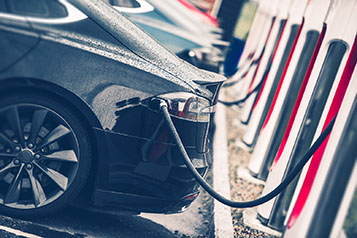 The current crop of electric vehicles available to consumers is somewhat limited and expensive, but automakers have plenty of new models in the pipeline. Bringing down vehicle costs will be necessary for widespread adoption. Photo: Adobe
The current crop of electric vehicles available to consumers is somewhat limited and expensive, but automakers have plenty of new models in the pipeline. Bringing down vehicle costs will be necessary for widespread adoption. Photo: Adobe
It’s an eye-catching figure for many that makes the costs of an EV suddenly more palatable. But not everyone will get that much back.
In this scenario, driving down car costs is crucial to bringing EVs to more than just the top tax brackets. Multiple U-M projects could eventually help do that, while others are reducing the total cost of ownership by creating additional value streams such as using the EVs for storing renewables, boosting resilience, or reducing peak power demands and therefore lowering utility bills as a recent review shows.
Taken altogether, U-M’s efforts on electrification serve a similar purpose: helping to bring a needed technology to the masses. And the stakes are as high as they come.
New technologies come and go, but few have the capacity to impact our quality of life in the same way electric vehicles do via their ability to help reduce emissions.